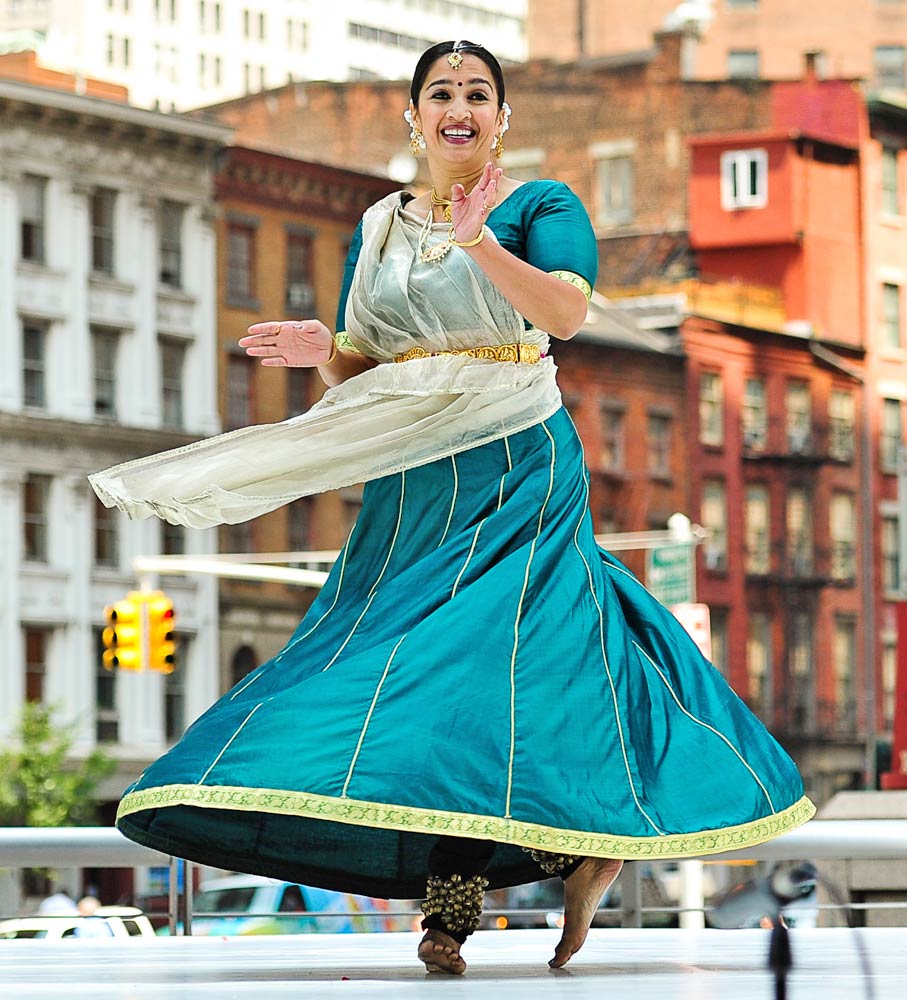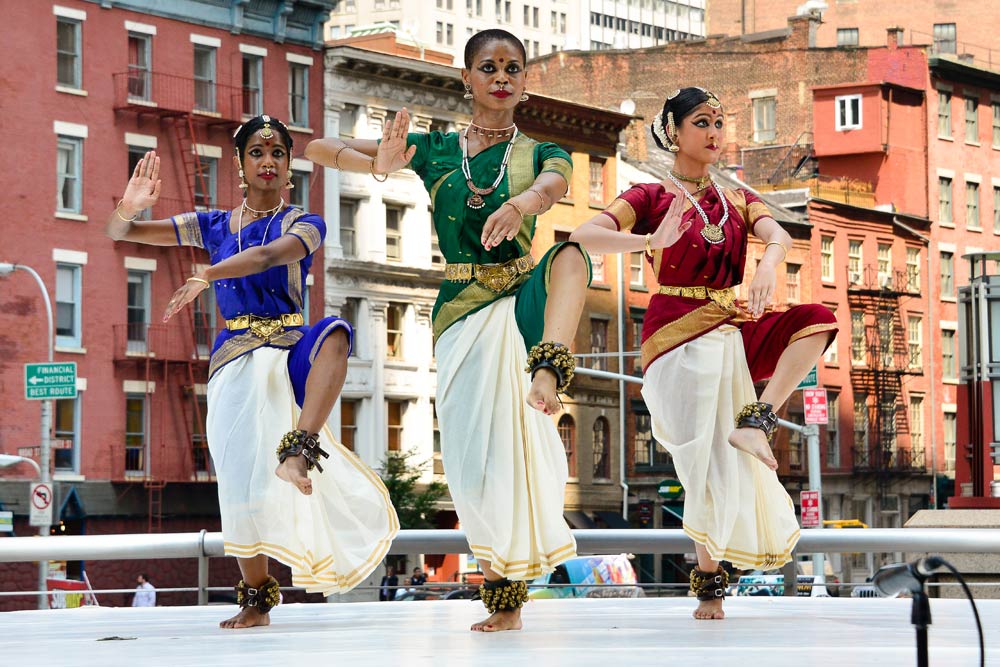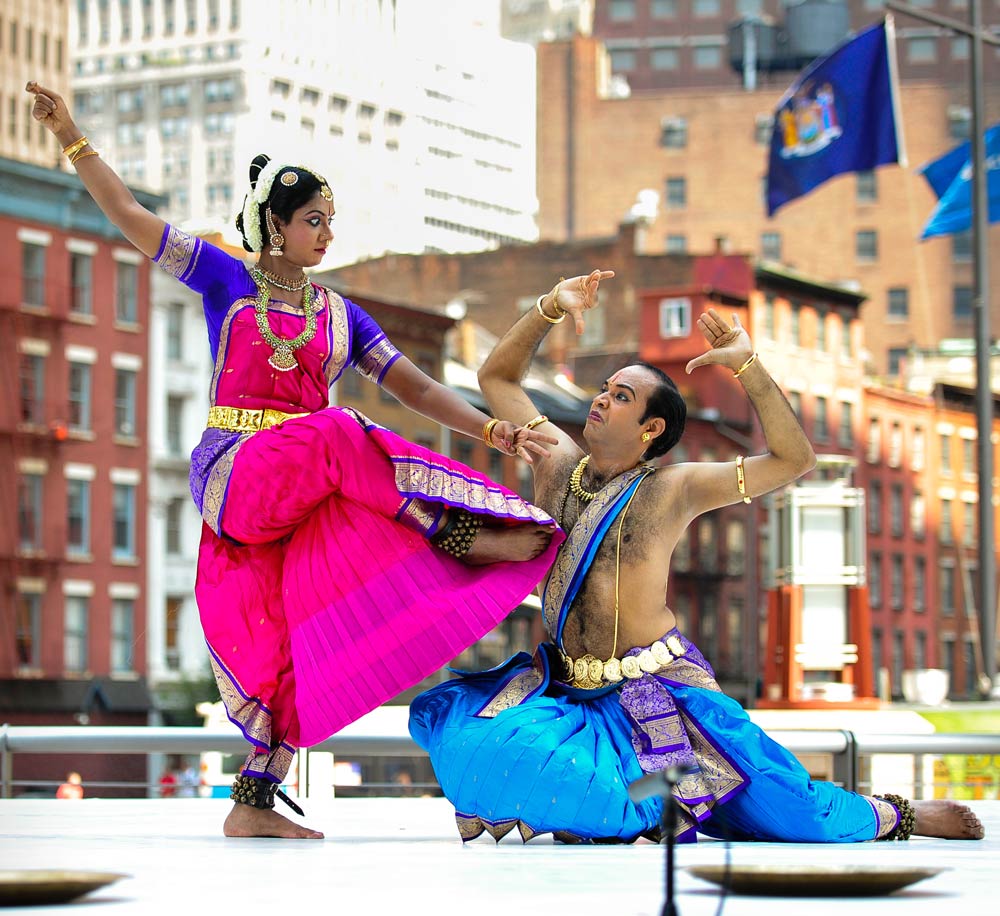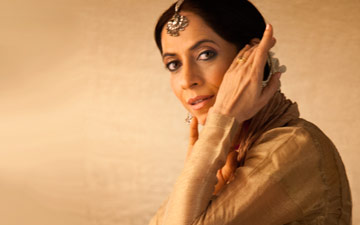
© Darial Sneed. (Click image for larger version)
Erasing Borders Festival of Indian Dance
Featuring: Bageshree Vaze, Sonali Skandan & Jiva Dance, Jaikishore and Padmavani Mosalikanti, Mayuri Indian Dance Ensemble
New York, Battery Park
17 August 2012
Festival website
August might be a quiet month for New York dance lovers, but it brings one of the most satisfying events of the year: the summer performances of the Erasing Borders Festival of Indian Dance, presented by the Indo-American Arts Council. Admission is free, and the festival boasts an unusually dramatic setting: an elevated stage outside One New York Plaza in Battery Park, against a backdrop of street traffic and skyscrapers.
This was my second Erasing Borders Festival, which impressed me last year for its wide variety. This year’s event, held on August 17 – the final day of the Downtown Dance Festival – was even more remarkable, offering a two-hour program of five diverse Indian dance styles, showing a balance of narrative and pure dance works, in an exciting mix of solos, duets and ensemble performances. The quality of the dancing was high.

© Darial Sneed. (Click image for larger version)
The highlight of the afternoon was Bageshree Vaze, a celebrated Kathak dancer, who performed two solos reminiscent of court dancing in 17th century India. Kathak, a style that originated in northern India, is known for its chakkars (pirouette-like spins), and in these Vaze proved her authority, rattling off rapid-fire turns with musical precision while stopping with complete control. In a particularly memorable passage in her first solo, Vaze stood at center stage and raised her skirt slightly, drawing attention to her intricate footwork: even while marking the most complex rhythms, her feet made contact with the floor from a number of points and from a variety of angles.
Another example of pure dance on the program, Sonali Skandan’s Infinite Form, was less successful. The piece explores the forms of Shiva, the supreme destroyer and transformer in the Hindu pantheon, through Bharata Natyam, a form of classical dance with roots in the southern state of Tamil Nadu. The choreography – full of statuesque balances and sharp lines formed by the arms – was attractively modest and had simple but powerful geometries, but it left me cold despite strong performances from its four dancers.

© Darial Sneed. (Click image for larger version)
Other works on the program were more theatrical in tone. In Durga Taranga, a work in the southeast Indian Kuchipudi style, the husband-and-wife duo Jaikishore and Padmavani Mosalikanti reenacted the story of the goddess Durga slaying the evil buffalo-headed demon, Mahishasura. Although their steps sometimes seemed too soft, their performance had no shortage of drama. Peaceful passages of pure dance blended into battle scenes fraught with collisions, and the two dancers often froze in tense, statuesque poses. The 20-minute piece ended with Padmavani standing over her husband while balancing on one leg, her bulging eyes glaring down at him menacingly.
Several steps in their duet also stood out as remarkably unique against the other forms of dance on the program. The pair at one point walked forward with their big toes intertwined. (A knowledgeable friend later informed me that this step illustrated one of the ways Lord Krishna walked as a child.) Later, the pair moved about the stage atop large brass plates (another element common to the form), their arms moving fluidly from one gesture to the next as their feet moved at a faster pace.

© Darial Sneed. (Click image for larger version)
The bill also demonstrated the surprisingly vast reach of Indian dance. In addition to the dancers of Indian descent, who hailed from multiple continents, the program opened and closed with performances by the Mayuri Indian Dance Ensemble, a company based in Petrozavodgsk, Russia. Its dance studio, which was founded in 1987 at the town’s Railway Workers Cultural Centre, offers training in classical forms such as Kathak and Bharata Natyam, but most of the five pieces the ensemble performed on Friday were in Bollywood style.
Vera Evgrafova’s swirling choreographies, set to popular songs of Indian cinema such as “Nimbooda Nimbooda” and “Aaja Nachle,” entertained and kept the eye engaged, and the colorful costumes (also made by Evgrafova, the studio’s founder) perfectly complemented the dancers’ high energy. (They also, I would venture to guess, attracted a number of passers-by to the plaza.) The ensemble ended with a tongue-in-cheek Bhangra dance that had three women dressed as men – with painted-on beards – flirting with three of their femininely costumed peers. The audience was then invited onstage to learn some moves from the professionals.

© Darial Sneed. (Click image for larger version)
The Mayuri dancers kept the charm flowing throughout the afternoon, but none was more captivating than Ksenia Sigalova, who danced a solo to “Mera Naam Chin Chin Chu,” an upbeat, rock-infused song from the 1958 film Howrah Bridge. The choreography, a mix of East and West, had Sigalova stomping wildly, tugging at her skirt, shuffling from side to side, and wiggling her hips, but the twists of the elbow and wrist were unmistakably Indian. The solo was the zaniest and hammiest part of the program, verging on ridiculous, but Sigalova gave herself to it completely. Her enthusiasm was irresistible.

















You must be logged in to post a comment.